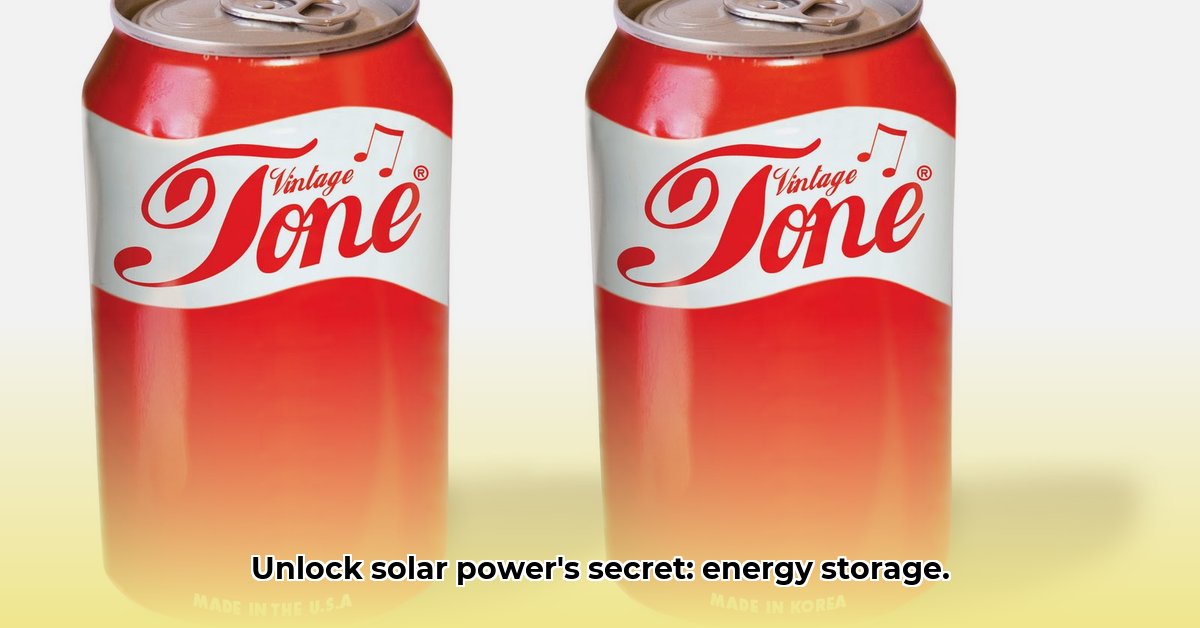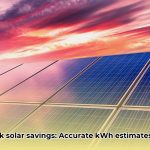So, you’re wondering if those solar panels on your roof can actually save up the sun’s energy for later? The simple answer is no, not by themselves. Think of them as super-efficient sunlight-to-electricity converters. But to really make the most of solar power, you need a way to store that electricity for when the sun’s not shining. That’s where energy storage comes in – it’s the key to unlocking the full potential of solar energy. For more information on solar energy storage, check out this helpful guide: Learn More. This guide will walk you through everything you need to know about home solar battery systems, from costs and payback to choosing the perfect setup for your home. We’ll also look at how energy storage helps keep the power grid running smoothly and how to safeguard your investment in the long run. We’ll cover all the major storage technologies, from batteries to other clever solutions, giving you the knowledge to make smart choices about your solar energy future.
Can Solar Panels Store Energy? Exploring Energy Storage System Types
So, can those shiny solar panels on your roof actually save energy for later? The short answer is no, not directly. Think of them like a super-efficient water faucet – they only deliver power when the sun’s shining. To use that power when the sun isn’t, you need a way to store it. That’s where things get interesting! But how exactly do we harness the sun’s power for later use?
How We Save the Sun’s Power: Batteries and Beyond
The most common way to stockpile that free solar electricity is with batteries. You’ve probably heard of lithium-ion batteries – they’re like giant, rechargeable power banks, and they’re currently the go-to for most homes. These batteries soak up the extra energy generated when the sun’s blazing, ready to power your lights and appliances later, when the sun dips below the horizon or when those pesky clouds roll in.
But batteries aren’t the only game in town. For larger-scale energy projects, think power plants or whole neighborhoods, there are other clever methods. One example is pumped hydro storage. Imagine a giant water tower, but instead of supplying water to your house, excess solar energy pumps water uphill to a reservoir. Then, when electricity is needed, the water flows back down, spinning turbines and generating power. It’s ingenious! Other big-scale storage ideas include compressed air storage (like a super-powerful air compressor) and thermal energy storage (think of storing the energy as heat).
Different Ways to Keep the Energy Flowing: A Closer Look at Different Storage Technologies
Let’s dive a little deeper into each of these energy-saving heroes:
| Technology | How It Works | Advantages | Disadvantages | Scalability | Cost |
|---|---|---|---|---|---|
| Lithium-ion Batteries | Uses lithium ions to store electrical energy; like a rechargeable power bank. | High energy density, relatively inexpensive, widely used and understood, fast response times, high round-trip efficiency. | Limited lifespan, potential safety hazards (though increasingly safer with advanced battery management systems), raw material limitations. | Very High | Moderate to Low |
| Pumped Hydro Storage | Pumps water uphill using excess energy to a reservoir; water flowing down generates power. | Long lifespan (50+ years), very efficient (70-80%), established technology, large storage capacity. | Needs specific geography (hills or mountains near a water source), significant upfront capital investment, potential environmental impacts. | Very High | Moderate |
| Compressed Air Energy Storage (CAES) | Compresses air to store energy in underground caverns or tanks; releasing it spins turbines to generate power. | Long lifespan, can be built in various locations (especially with underground storage), potential for large-scale storage. | Lower energy density than other methods, some energy is lost during compression and release (though advanced adiabatic systems are improving efficiency). | Medium | High |
| Thermal Energy Storage (TES) | Stores energy as heat or cold, typically using molten salts, water, or specialized materials. | Potential for long-duration storage, adaptable to different applications (heating, cooling, and power generation), can utilize waste heat. | Lower efficiency compared to pumped hydro, technology still under development for some applications, material stability can be an issue. | Medium | High |
| Flow Batteries | Stores energy in liquid electrolytes; energy is released by pumping the electrolytes through a membrane. | Highly scalable, long lifespan (20+ years), independent scaling of power and energy capacity, non-flammable electrolytes. | Lower energy density than lithium-ion, higher upfront costs compared to lithium-ion, technology still maturing. | Very High | High |
Powering Your Home vs. Powering a City: Residential vs. Utility-Scale Storage
The energy needs and best solutions differ greatly between homes and vast power grids. Homes typically use smaller, more manageable lithium-ion battery systems due to their high energy density and relatively low cost. But for utilities supplying power to entire cities, they’ll often use a mix of methods – massive pumped hydro systems for bulk storage, large-scale battery farms for quick response, and CAES for long-duration needs – to ensure a constant, reliable flow of energy. Furthermore, utility-scale projects must consider grid stability and ancillary services, such as frequency regulation, which residential systems typically do not address.
What factors should be considered when determining appropriate storage solutions for different scales?
Practical Steps for Everyone Involved: From Homeowners to Power Companies
Here’s how different groups can use this technology to its full potential:
For Residential Users:
- Assess your energy needs: Figure out how much energy you use daily and how much your solar panels produce (consider peak demand, average consumption, and time-of-use rates from your utility).
- Research battery systems: Look at different battery options, paying close attention to warranties, safety features, depth of discharge (DoD), and round-trip efficiency (ensure compliance with local safety standards and building codes).
- Consult a professional: Talk to an experienced and certified solar installer. They can help you choose the right system size and location, navigate permitting processes, and understand available incentives and rebates (seek certified and insured installers).
- Consider future needs: Think about potential future increases in energy consumption, such as purchasing an electric vehicle or adding electric appliances.
For Utility Companies:
- Diversify storage options: Don’t put all your eggs in one basket. Use a mix of battery, pumped hydro, CAES, and other storage technologies to meet diverse grid needs e.g., frequency regulation, peak shaving, and long-term energy balancing (consider the long-term operational costs, environmental impacts, and resource availability).
- Invest in smart grids: Modern grid technology helps maximize the efficiency of energy distribution and storage (implement real-time monitoring and control systems that integrate renewable energy sources and storage assets).
- Work with policymakers: Support policies that encourage the development and use of solar and energy storage technologies (advocate for streamlined permitting processes, fair compensation for grid services provided by energy storage, and long-term energy planning that incorporates storage).
- Prioritize grid resilience: Implement standards and protocols for energy storage systems to ensure they can withstand extreme weather events and other grid disturbances.
The Future of Energy Storage: Innovative Storage Solutions on the Horizon
The world of energy storage is incredibly dynamic. Scientists are constantly developing better batteries with higher energy density (meaning they can store more power in a smaller space), longer lifespans, faster charging rates, and lower costs. Solid-state batteries, which replace the liquid electrolyte with a solid material, promise enhanced safety and energy density. We’re also exploring exciting new storage methods – flow batteries, for example, show a lot of promise due to their scalability and long lifespan, and hydrogen storage as a longer-term solution.
While progress is rapid, some challenges remain, particularly in scaling up some technologies to meet the demands of a growing energy need and addressing environmental concerns related to material sourcing and disposal. But the future is bright!
What are the most promising avenues for research and development in energy storage?
- Advanced battery chemistries: Focus on developing batteries that use more abundant and sustainable materials, such as sodium-ion, magnesium-ion, and zinc-air batteries.
- Solid-state batteries: Improve the performance and scalability of solid-state batteries to make them commercially viable.
- Flow batteries: Reduce the cost and improve the energy density of flow batteries to make them competitive with lithium-ion in a wider range of applications.
- Thermal energy storage: Develop more efficient and cost-effective thermal energy storage systems for both heating and cooling applications.
- Hydrogen storage: Advance hydrogen production, storage, and utilization technologies to enable hydrogen to play a significant role in the future energy system.
Key Takeaways:
- Solar energy storage is crucial for overcoming solar energy’s intermittency and maximizing the value of solar investments.
- Many technologies are available, each with their own advantages and disadvantages in terms of cost, performance, scalability, and environmental impact.
- A comprehensive lifecycle cost analysis is critical for making informed decisions about which storage technology is best suited for
- Hydro Extrusions USA Leads North American Aluminum Profile Solutions - December 28, 2025
- Hydro North America Leads Aluminum Extrusion Solutions Across Diverse Industries - December 27, 2025
- Hydro Extrusion North America Provides Custom Solutions Across Diverse - December 26, 2025
















